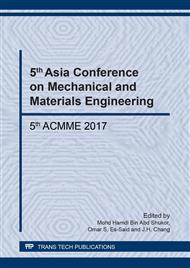p.231
p.237
p.243
p.249
p.255
p.263
p.269
p.275
p.280
Synthesis of Hydrophobic Viscose Rayon Fiber Using Nanorod Silica and Chitosan as Surface Modifier
Abstract:
Hydrophobic textile is a type of smart fabrics. Some of it are commonly coated with small particles and finally treated by water repellent agent in terms of acquiring its hydrophobic property. This research describes how hydrophobic textile are formed from its initial form of fabrics and even yarn, which are fibers. Synthesis process was commenced through wet spinning of viscose rayon mixed with nanorod silica which has been formerly produced with sol gel method. These fibers were then coated with chitosan and dried out by vacuum instrument. Scanning Electron Microscopy (SEM) results showed that nanorod silica were well attached on the fibers. Followed by Energy Dispersive Spectroscopy (EDS) mapping characterization, silica particles were moderately dispersed on its surface, performing roughness and creating hydrophobic effect. In addition, several characterization methods correlated to water absorption of the fibers were conducted. Fibers swelling percentage decreased from 50.2% to 17.13%, while moisture regain (MR) number also decreased from 14.28 to 10.72.
Info:
Periodical:
Pages:
255-260
Citation:
Online since:
November 2017
Keywords:
Price:
Сopyright:
© 2017 Trans Tech Publications Ltd. All Rights Reserved
Share:
Citation:


